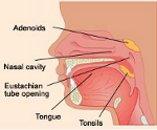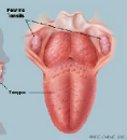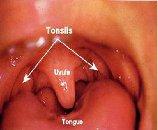Tonsils and Adenoids
Tonsils and Adenoids
What are tonsils and adenoids?



The tonsils are two clumps of tissue, on either side of the throat, embedded in a pocket at the side of the palate (roof of the mouth). The lower edge of each tonsil is beside the tongue...way in the back of the throat.
The adenoids are a single clump of tissue in the back of the nose (nasopharynx). They are located (in the adult) on the back wall of the throat (pharynx)...about one inch above the uvula (the little teardrop shaped piece of tissue that hangs down in the middle of the soft palate
The tonsils are part of the lymphatic system, which helps to fight infections. However, removal of the tonsils does not seem to increase susceptibility to infection. Tonsils vary widely in size and swell in response to infection
What are the functions of tonsils and adenoids?
The tonsils and the adenoids are mostly composed of lymphoid tissue, which is found throughout the gastrointestinal tract and on the base of the tongue. Lymphoid tissue is composed of lymphocytes, which are mostly involved in antibody production. Since we generally consider antibody production to be a good thing, many studies have been performed to try to clarify the importance of the tonsils. There seems to be no adverse effect on the immune status or health of patients who have had them removed. Any noticeable effect has generally been positive. It appears that the tonsils and adenoids were not "designed" to effectively handle the multitude of viral infections that occur in children in an urban population. Rather, the immune system, including the tonsils and adenoids, developed during an era where the child was rarely exposed to a large number of other people and the germs they carried. It may also be that these organs are relatively more important in dealing with certain types of infections, such as worms or other parasites that are relatively uncommon in today's society. It is clear that in many cases, the tonsils and/or the adenoids become "dysfunctional" and are more of a liability than an asset.
Problems associated with Tonsils
- Blockage of the throat: This is now the most common reason for removal of tonsils. The tonsils can be large enough to impede breathing, swallowing, or clear speech production. The blockage of breathing can range from simple "mouth breathing" to severe snoring, or sleep apnea (blockage of breathing at night). The health risks of this can be slight to life-threatening. Not all tonsils that appear to be large are actually causing obstruction. A history and an examination by a skilled practitioner is usually sufficient for the diagnosis.
- Chronic and recurrent tonsillitis/ Sore throats this used to be the most common reason for removal and remains so in some parts of the world. Some patients will have frequent severe bouts of tonsillitis.
- White debris in the tonsils / "chronic cryptic tonsillitis": The tonsils contain many pits and pockets...called crypts. These, in some patients tend to become impacted with white foul-smelling (especially to the owner) debris that is composed of bacteria and dead cells. It may cause a low grade intermittent sore throat. Antibiotics are only transiently helpful. The only consistent cure is a tonsillectomy.
- Unusual enlargement or appearance like any other tissue, the tonsils can be the site of benign or malignant tumors. An unusual or markedly enlarged tonsil is sometimes seen in this situation. Lymphoma is the most common tumor of the tonsil in children. In adults, lymphoma or carcinoma can be seen.
What are the complications of tonsillectomy?
Most surgical procedures share the general risks of anesthesia, bleeding, and infection. The anesthetic risk is, in general, proportional to the health of the patient; and serious problems should be very rare. Bleeding is most commonly encountered in a delayed fashion...five to ten days after surgery...when an eschar (scab) comes off. Post-operative bleeding is more likely in teenagers and adults, as opposed to younger children (who have smaller vessels). The area where the tonsils were removed (the tonsillar fossae) always become colonized with high numbers of bacteria, and often cause a low-grade fever. Serious infections are very rare. If tonsils are very large, speech may be different post-operatively (often temporarily high-pitched and "whiney"). Most often the post-op speech is actually more normal. Remember...very rarely, complications of tonsillectomy death very rare like all other surgery (or any other surgery); so no surgical procedure should be undertaken lightly.
Tonsil Conditions
- Acute tonsillitis: A bacteria or virus infects the tonsils, causing swelling and a sore throat. The tonsil may develop a gray or white coating (exudate).
- Chronic tonsillitis: Persistent infection of the tonsils, sometimes as a result of repeated episodes of acute tonsillitis.
- Peritonsillar abscess: An infection creates a pocket of pus next to the tonsil, pushing it toward the opposite side. Peritonsillar abscesses must be drained urgently.
- Acute mononucleosis: Usually caused by the Epstein-Barr virus, “mono” causes severe swelling in the tonsils, fever, sore throat, rash, and fatigue
- Strep throat: Streptococcus, a bacterium, infects the tonsils and throat. Fever and neck pain often accompany the sore throat.
- Enlarged (hypertrophic) tonsils: Large tonsils reduce the size of the airway, making snoring or sleep apnea more likely.
- Tonsilloliths (tonsil stones): Tonsil stones, or tonsilloliths, are formed when this trapped debris hardens, or calcifies.
Tonsil tests
- Throat (pharynx) swab: A doctor rubs a cotton swab on the tonsils and throat and sends the swab for tests. Usually this is done to check for bacteria such as Streptococcus.
- Monospot test: A blood test can detect certain antibodies, which can help confirm that a person’s symptoms are due to mononucleosis.
- Epstein-Barr virus antibodies: If a monospot test is negative, antibodies in the blood against EBV might help diagnose mononucleosis.
Tonsil Treatments
- Antibiotics: Tonsillitis due to bacterial infection can be cured with antibiotics.
- Abscess drainage: A peritonsillar abscess generally must be punctured with a needle, to allow the infection to drain and heal Tonsillectomy: In cases of tonsils that are too large or repeatedly infected, surgery to remove them may be necessary.
Source: www.homoeopathyclinic.com
Last Modified : 9/14/2023
